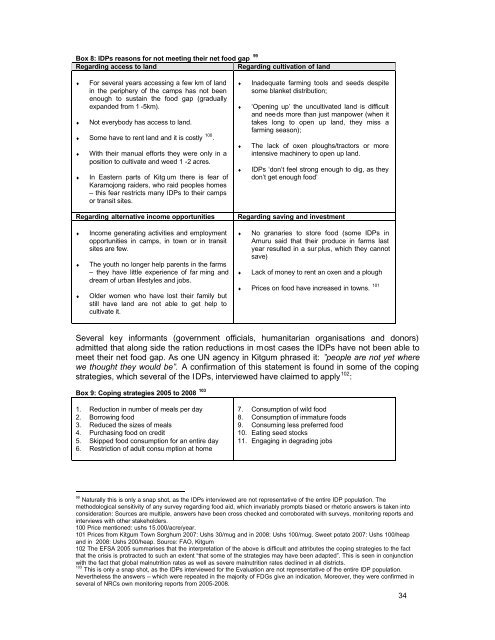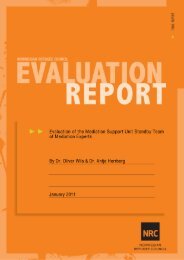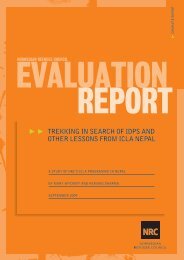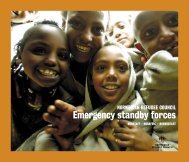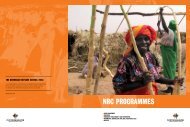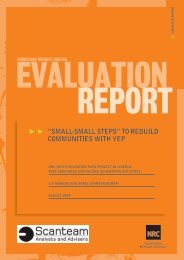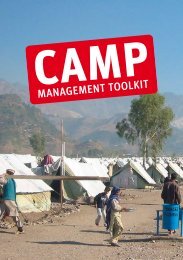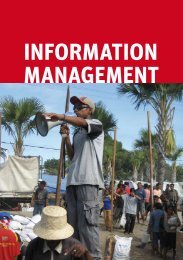evaluation of general food distribution in northern uganda: gulu ...
evaluation of general food distribution in northern uganda: gulu ...
evaluation of general food distribution in northern uganda: gulu ...
Create successful ePaper yourself
Turn your PDF publications into a flip-book with our unique Google optimized e-Paper software.
Box 8: IDPs reasons for not meet<strong>in</strong>g their net <strong>food</strong> gap 99Regard<strong>in</strong>g access to landRegard<strong>in</strong>g cultivation <strong>of</strong> land♦♦For several years access<strong>in</strong>g a few km <strong>of</strong> land<strong>in</strong> the periphery <strong>of</strong> the camps has not beenenough to susta<strong>in</strong> the <strong>food</strong> gap (graduallyexpanded from 1 -5km).Not everybody has access to land.♦ Some have to rent land and it is costly 100 .♦♦With their manual efforts they were only <strong>in</strong> aposition to cultivate and weed 1 -2 acres.In Eastern parts <strong>of</strong> Kitg um there is fear <strong>of</strong>Karamojong raiders, who raid peoples homes– this fear restricts many IDPs to their campsor transit sites.♦♦♦♦Inadequate farm<strong>in</strong>g tools and seeds despitesome blanket <strong>distribution</strong>;‘Open<strong>in</strong>g up’ the uncultivated land is difficultand needs more than just manpower (when ittakes long to open up land, they miss afarm<strong>in</strong>g season);The lack <strong>of</strong> oxen ploughs/tractors or more<strong>in</strong>tensive mach<strong>in</strong>ery to open up land.IDPs ‘don’t feel strong enough to dig, as theydon’t get enough <strong>food</strong>’Regard<strong>in</strong>g alternative <strong>in</strong>come opportunitiesRegard<strong>in</strong>g sav<strong>in</strong>g and <strong>in</strong>vestment♦♦♦Income generat<strong>in</strong>g activities and employmentopportunities <strong>in</strong> camps, <strong>in</strong> town or <strong>in</strong> transitsites are few.The youth no longer help parents <strong>in</strong> the farms– they have little experience <strong>of</strong> far m<strong>in</strong>g anddream <strong>of</strong> urban lifestyles and jobs.Older women who have lost their family butstill have land are not able to get help tocultivate it.♦♦No granaries to store <strong>food</strong> (some IDPs <strong>in</strong>Amuru said that their produce <strong>in</strong> farms lastyear resulted <strong>in</strong> a sur plus, which they cannotsave)Lack <strong>of</strong> money to rent an oxen and a plough♦ Prices on <strong>food</strong> have <strong>in</strong>creased <strong>in</strong> towns. 101Several key <strong>in</strong>formants (government <strong>of</strong>ficials, humanitarian organisations and donors)admitted that along side the ration reductions <strong>in</strong> most cases the IDPs have not been able tomeet their net <strong>food</strong> gap. As one UN agency <strong>in</strong> Kitgum phrased it: ”people are not yet wherewe thought they would be”. A confirmation <strong>of</strong> this statement is found <strong>in</strong> some <strong>of</strong> the cop<strong>in</strong>gstrategies, which several <strong>of</strong> the IDPs, <strong>in</strong>terviewed have claimed to apply 102 :Box 9: Cop<strong>in</strong>g strategies 2005 to 2008 1031. Reduction <strong>in</strong> number <strong>of</strong> meals per day2. Borrow<strong>in</strong>g <strong>food</strong>3. Reduced the sizes <strong>of</strong> meals4. Purchas<strong>in</strong>g <strong>food</strong> on credit5. Skipped <strong>food</strong> consumption for an entire day6. Restriction <strong>of</strong> adult consu mption at home7. Consumption <strong>of</strong> wild <strong>food</strong>8. Consumption <strong>of</strong> immature <strong>food</strong>s9. Consum<strong>in</strong>g less preferred <strong>food</strong>10. Eat<strong>in</strong>g seed stocks11. Engag<strong>in</strong>g <strong>in</strong> degrad<strong>in</strong>g jobs99Naturally this is only a snap shot, as the IDPs <strong>in</strong>terviewed are not representative <strong>of</strong> the entire IDP population. Themethodological sensitivity <strong>of</strong> any survey regard<strong>in</strong>g <strong>food</strong> aid, which <strong>in</strong>variably prompts biased or rhetoric answers is taken <strong>in</strong>toconsideration: Sources are multiple, answers have been cross checked and corroborated with surveys, monitor<strong>in</strong>g reports and<strong>in</strong>terviews with other stakeholders.100 Price mentioned: ushs 15.000/acre/year.101 Prices from Kitgum Town Sorghum 2007: Ushs 30/mug and <strong>in</strong> 2008: Ushs 100/mug. Sweet potato 2007: Ushs 100/heapand <strong>in</strong> 2008: Ushs 200/heap. Source: FAO, Kitgum102 The EFSA 2005 summarises that the <strong>in</strong>terpretation <strong>of</strong> the above is difficult and attributes the cop<strong>in</strong>g strategies to the factthat the crisis is protracted to such an extent “that some <strong>of</strong> the strategies may have been adapted”. This is seen <strong>in</strong> conjunctionwith the fact that global malnutrition rates as well as severe malnutrition rates decl<strong>in</strong>ed <strong>in</strong> all districts.103This is only a snap shot, as the IDPs <strong>in</strong>terviewed for the Evaluation are not representative <strong>of</strong> the entire IDP population.Nevertheless the answers – which were repeated <strong>in</strong> the majority <strong>of</strong> FDGs give an <strong>in</strong>dication. Moreover, they were confirmed <strong>in</strong>several <strong>of</strong> NRCs own monitor<strong>in</strong>g reports from 2005-2008.34


